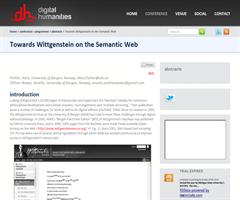Cargando ...
Towards Wittgenstein on the Semantic Web | Digital Humanities 2012
21/03/2013

Introduction
Ludwig Wittgenstein’s 20,000 pages of manuscripts and typescripts (his ‘Nachlass’) display his continuous philosophical development and contain revisions, rearrangements and ‘multiple versioning.’ Their publication poses a number of challenges, for book as well as for digital editions (Huitfeldt 1994). Since its creation in 1990, the Wittgenstein Archives at the University of Bergen (WAB) has tried to meet these challenges through digital editorial philology. In 2000, WAB’s ‘Bergen Electronic Edition’ (BEE) of Wittgenstein’s Nachlass was published by Oxford University Press, and in 2009, 5000 pages from the Nachlass were made freely available (Open Access) on the Web ( http://www.wittgensteinsource.org/, cf. Fig. 1). Since 2001, XML-based text encoding (TEI P5) has been one of several central ingredients through which WAB has worked continuously to improve access to Wittgenstein’s manuscripts.
Categories:
Copyright
- The original license is kept.
- Web 3.0 (vídeo en español)
- Web Semántica (vídeo en inglés)
- Introducing Linked Data And The Semantic Web
- Linked Open Data: The Essentials book
- Industrialized Linked Data
- Cómo reutilizar Open Linked Data
- Semantic Web Standards Wiki
- RDF Pro: Complete Semantic Web Tools Suite
- Could data save newspapers?
- Búsquedas facetadas
